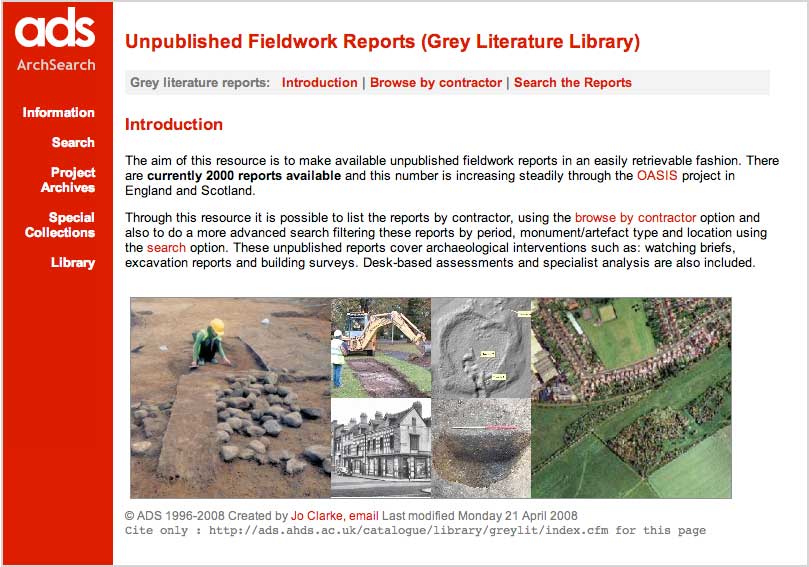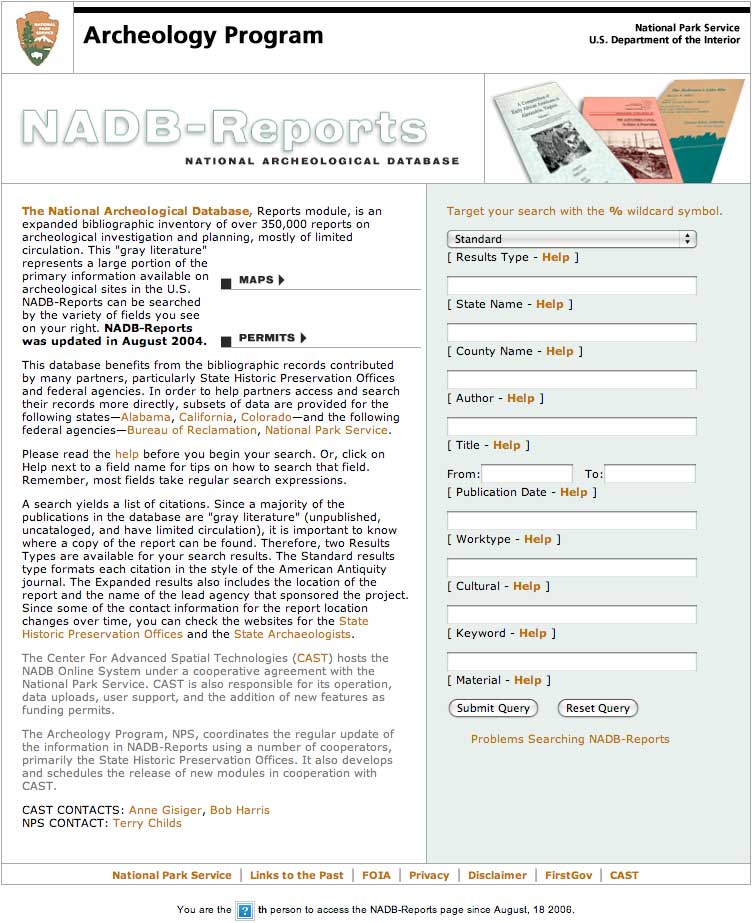
|
|
 |
Grey Literature: An Obvious Candidate for Online Access
Harrison Eiteljorg, II
(See email contacts page for the author's email address.)
Writing in the Spring, 2004, issue of the CSA Newsletter, William Kilbride and Catherine Hardman discussed the early stages of adding grey literature to the holdings of the Archaeology Data Service in York, England, as part of the OASIS project (Online Access to the Index of Archaeological Investigations).1 They said, "A pilot project of 'grey literature reports' from Worcestershire County Council has been undertaken to demonstrate the potential."
Since that early and careful statement the ADS has worked effectively to expand the resource and recently sent out an email announcement that, "The ADS is pleased to announce that the recent addition of over 650 new reports to the online library of grey literature brings the total number available for download to 2000." (The resource may be found at "http://ads.ahds.ac.uk/catalogue/library/greylit/.")

Fig. 1 - The Home Page of the Grey Literature Library at the Archaeology Data Service.
Taken alone, this is not a monumental achievement. However, as an indication of the careful, steady progress of the ADS in bringing digital aids to archaeolgists working in Britain, it is a very strong indication of the skills and value of their work. What is available, after all, is not simply a listing of the grey literature works but a search system leading to the actual texts, in HTML or PDF format. In the best tradition of the careful archivist, the ADS is preserving information that is subject to loss. The ADS is helping to fulfill our discipline's ethical responsibility since the information may have been gained at the cost of destroying the archaeological evidence; certainly involved the expenditure of considerable time, effort, and skill; and certainly cost someone (most likely the public) money to excavate and study. Indeed, this is just the kind of careful, thoughtful work that won the Archaeology Data Service continued funding from the British Arts and Humanities Research Council in the face of substantial cuts elsewhere.

Fig. 1 - The Home Page of the National Archaeological Database.
The National Park Service and the Center for Advanced Spatial technologies at the University of Arkansas provide a resource for grey literature from the United States, the National Archaeologicla Database (at http://www.cast.uark.edu/other/nps/nadb/nadb.mul.html). At this site there "is an expanded bibliographic inventory of over 350,000 reports on archeological investigation and planning, mostly of limited circulation." (The Smithsonian also has some grey literature in the field, but we were unable to access even a catalog.) The number of entries is enormous, though there have been no additions since 2004. (Even then the changes were corrections rather than additions.) It may not be reasonable to suggest that the NADB could digitize all the sources in its database. Or is it? Those 350,000 paper reports come from the entire country, and they are stored somewhere by someone, either an agency of some level of government or the contractor or both. If it was worth the effort and expense to find the information in the first instance, is it not worth some additional expense to preserve it?2 If it is possible to digitize 2 million dissertations and theses (see "Dissertations on the Internet," by Susan C. Jones in this issue of the Newsletter - see http://csanet.org/newsletter/spring08/nls0802.html), digitizing these grey literature reports should not be impossible. The question seems not to be one of possibilities but of priorities. It seems to me that we who compose the archaeological community should take these issues very seriously and give them more than the lip service that is too often the extent of our interest; if we do not vigorously advocate careful and effective preservation of and access to archaeological records, who will?
-- Harrison Eiteljorg, II
1. "It's the Small Things that Count: Digital Preservation and Small Scale Research Projects in the UK," by William Kilbride and Catherine Hardman; CSA Newsletter,XVII, 1; Spring, 2004. (http://csanet.org/newsletter/spring04/nls0402.html) Return to text.
2. It is important to note that some so-called grey literature may be more about legal matters than archaeology and may therefore be of little or no importance to the archaeological community. It is easy to paint with a broad brush but not necessarily correct. Return to text.
For other Newsletter articles concerning the use of electronic media in the humanities, consult the Subject index.
Next Article: The Amazon Kindle: Reading an Electronic Book
Table of Contents for the Spring, 2008 issue of the CSA Newsletter (Vol. XXI, no. 1)
 Table of Contents for all CSA Newsletter issues on the Web
Table of Contents for all CSA Newsletter issues on the Web